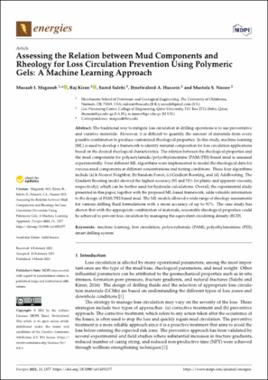| dc.contributor.author | Magzoub, Musaab I. | |
| dc.contributor.author | Kiran, Raj | |
| dc.contributor.author | Salehi, Saeed | |
| dc.contributor.author | Hussein, Ibnelwaleed A. | |
| dc.contributor.author | Nasser, Mustafa S. | |
| dc.date.accessioned | 2021-04-28T15:27:50Z | |
| dc.date.available | 2021-04-28T15:27:50Z | |
| dc.date.issued | 2021-03-03 | |
| dc.identifier.citation | Magzoub MI, Kiran R, Salehi S, Hussein IA, Nasser MS. Assessing the Relation between Mud Components and Rheology for Loss Circulation Prevention Using Polymeric Gels: A Machine Learning Approach. Energies. 2021; 14(5):1377. https://doi.org/10.3390/en14051377 | en_US |
| dc.identifier.uri | https://hdl.handle.net/11244/329490 | |
| dc.description.abstract | The traditional way to mitigate loss circulation in drilling operations is to use preventative and curative materials. However, it is difficult to quantify the amount of materials from every possible combination to produce customized rheological properties. In this study, machine learning (ML) is used to develop a framework to identify material composition for loss circulation applications based on the desired rheological characteristics. The relation between the rheological properties and the mud components for polyacrylamide/polyethyleneimine (PAM/PEI)-based mud is assessed experimentally. Four different ML algorithms were implemented to model the rheological data for various mud components at different concentrations and testing conditions. These four algorithms include (a) k-Nearest Neighbor, (b) Random Forest, (c) Gradient Boosting, and (d) AdaBoosting. The Gradient Boosting model showed the highest accuracy (91 and 74% for plastic and apparent viscosity, respectively), which can be further used for hydraulic calculations. Overall, the experimental study presented in this paper, together with the proposed ML-based framework, adds valuable information to the design of PAM/PEI-based mud. The ML models allowed a wide range of rheology assessments for various drilling fluid formulations with a mean accuracy of up to 91%. The case study has shown that with the appropriate combination of materials, reasonable rheological properties could be achieved to prevent loss circulation by managing the equivalent circulating density (ECD). | en_US |
| dc.description.sponsorship | This research was funded by Qatar National Research Fund (a member of Qatar Foundation), grant number NPRP10-0125-170240 and The APC was funded by OU Libraries. Open Access fees paid for in whole or in part by the University of Oklahoma Libraries. | en_US |
| dc.language | en_US | en_US |
| dc.rights | Attribution 4.0 International | * |
| dc.rights.uri | https://creativecommons.org/licenses/by/4.0/ | * |
| dc.subject | Machine Learning | en_US |
| dc.subject | Lost Circulation | en_US |
| dc.subject | Polyacrylamide (PAM) | en_US |
| dc.subject | Polyethyleneimine (PEI) | en_US |
| dc.subject | Smart Drilling System | en_US |
| dc.title | Assessing the Relation between Mud Components and Rheology for Loss Circulation Prevention Using Polymeric Gels: A Machine Learning Approach | en_US |
| dc.type | Article | en_US |
| dc.description.peerreview | Yes | en_US |
| dc.identifier.doi | 10.3390/en14051377 | en_US |
| ou.group | Mewbourne College of Earth and Energy::Mewbourne School of Petroleum and Geological Engineering | en_US |

